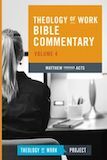Conflict Resolution (Matthew 18:15-35)
Bible Commentary / Produced by TOW Project.jpg)
Walls Break Down When We Deal With Conflict on a Personal Level |
All workplaces experience conflict. In this passage, Jesus gives us a template for dealing with someone who has wronged us. He does not say, “Get even!” or “Strike back!” Instead, he lays out a process that begins with seeking one-on-one to be reconciled. The beatitude of meekness (Matt 5:5) means putting aside your self-justification long enough to express yourself respectfully and factually to the one who has hurt you, and to open yourself to their perspective (Matt. 18:15). This does not mean submitting to further abuse, but opening yourself to the possibility that your perception is not universal. But suppose that doesn’t resolve the conflict? The fallback second step is to ask people who know you both to go with you as you take up the issue again with the person who caused pain or injury. If the conflict still is not resolved, then bring the matter to the leadership (the church, in Matthew 18:16, which is addressing church conflict specifically) for an impartial judgment. If that judgment doesn’t resolve the issue, the offender who fails to abide by the judgment is removed from the community (Matt. 18:17).
Although Jesus was speaking about conflict with “another member of the church” (Matt. 18:15), his method is a remarkable precursor to what is now recognized as best practice in the workplace. Even in the finest workplaces, conflicts arise. When they do, the only effective resolution is for those in conflict to engage each other directly, not to complain to others. Rather than play out a personal conflict in front of an audience, get with the person privately. In the age of electronic communication, Jesus’ approach is more important than ever. All it takes is a name or two in the “cc:” line or one press of the “reply all” button to turn a simple disagreement into an office feud. Even though two people could keep an email chain to themselves, the possibilities for misunderstanding are multiplied when an impersonal medium such as e-mail is used. It might be best to take Jesus’ advice literally, “Go and point out the fault when the two of you are alone” (Matt. 18:15).
Pointing out the fault is a two-way street. We need to be open to hearing faults pointed out to us as well. Listening—Jesus mentions listening three times in these three verses—is the crucial element. Contemporary conflict resolution models usually focus on getting the parties to listen to each another, even while preserving the option to disagree. Often, attentive listening leads to the discovery of a mutually acceptable resolution. If it doesn’t, then others with the appropriate skills and authority are asked to get involved.










